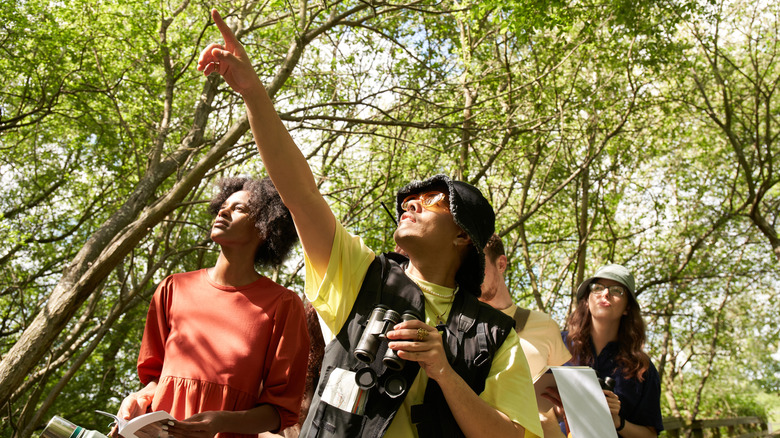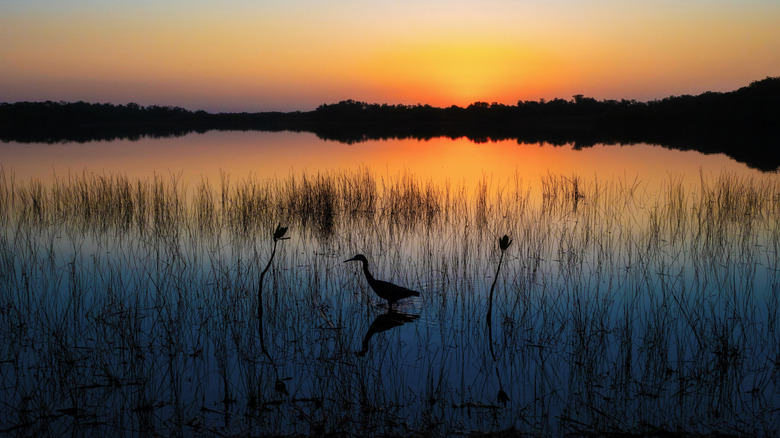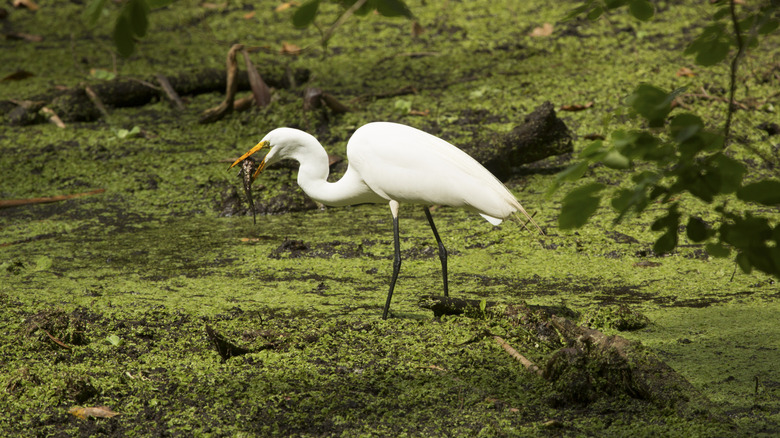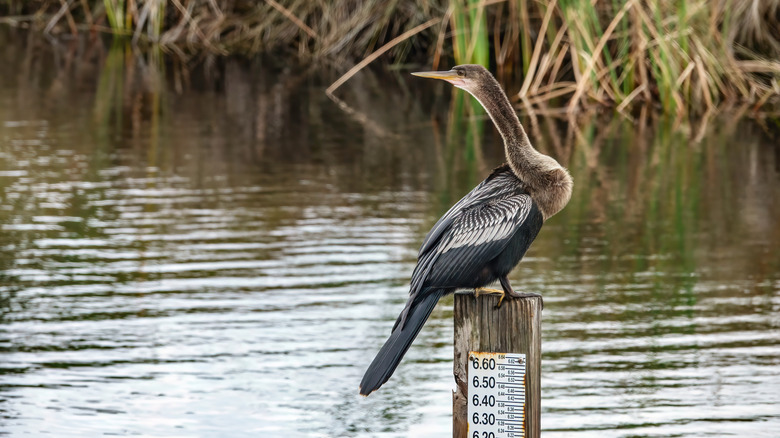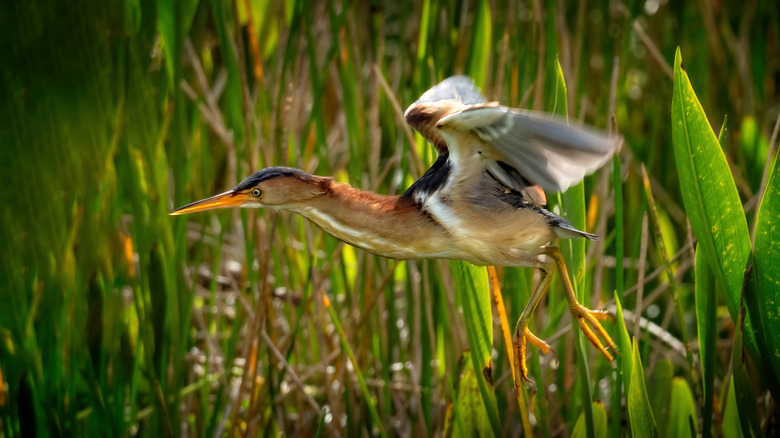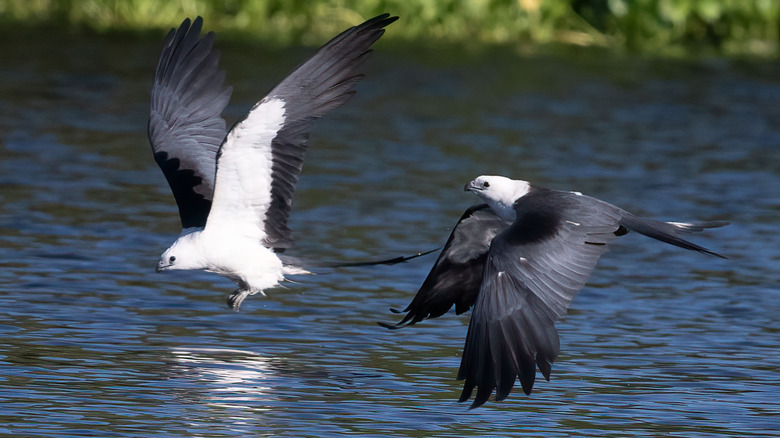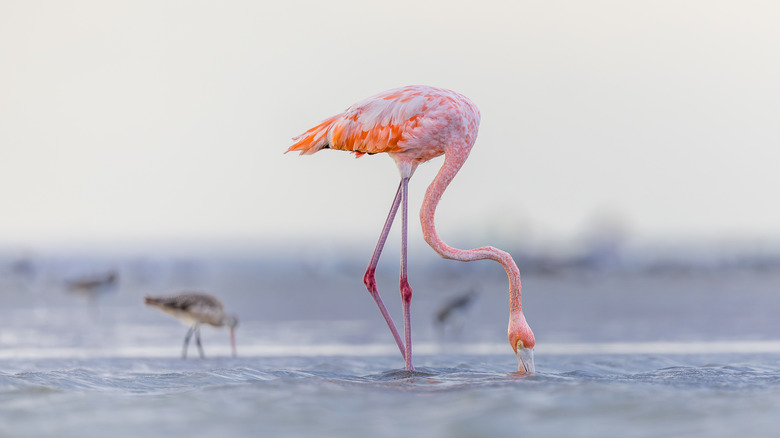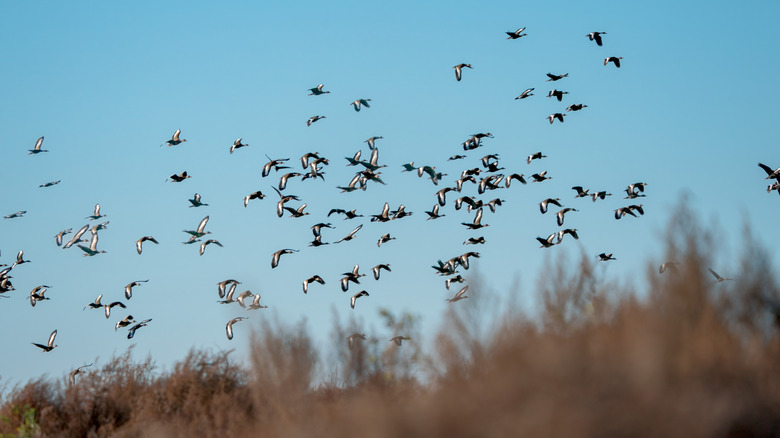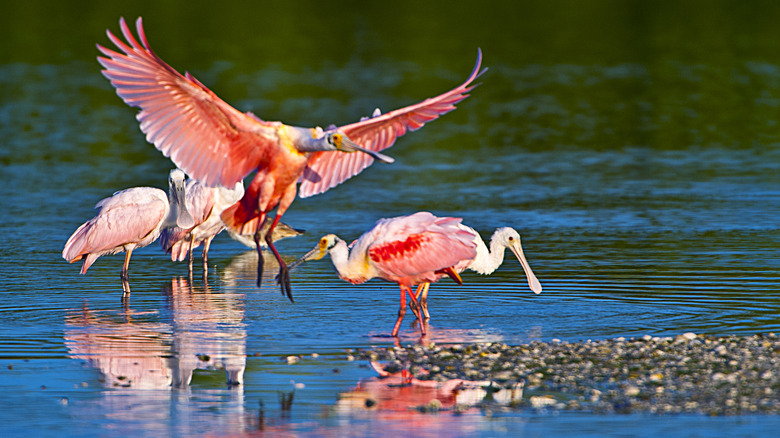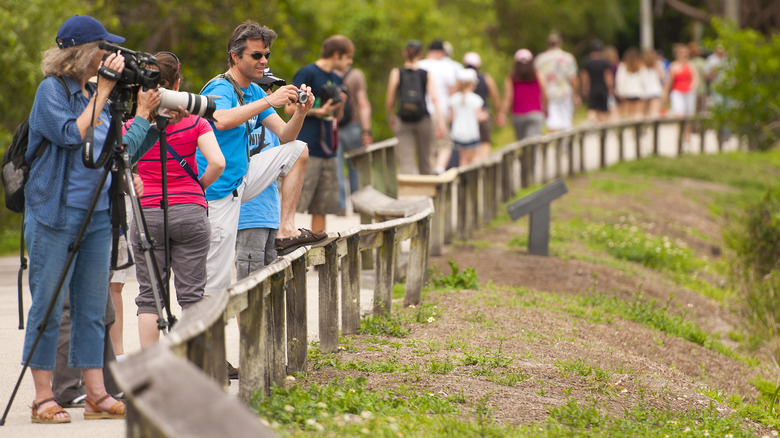The Best Destinations In Florida For Birdwatching, According To Research
You might have heard of "snowbirds" flocking to the Sunshine State every warm season, but did you know that Florida is also home to a diverse population of actual birds? With its tropical climate, miles of shoreline, and diverse habitats ranging from marshy wetlands to pine forests and salty estuaries, this state is a must-see spot for many North American bird species on their yearly migration routes. If birdwatching is your bag, Florida awaits.
As for the watchers who are obsessed with tracking down new avian species? It's also a must-see spot for them. Whether you're a newbie who's just breaking into the birder community or a tried-and-true veteran armed with your trusty binoculars, Florida is the perfect location to explore the skies (and the waterlines) for colorful and unique species of birds. It's a state known for its biodiversity, meaning you can chase the flutter of a ruby-throated hummingbird and hunt for the prehistoric wingspan of a wood stork all in the same evening.
To pinpoint the best birdwatching destinations across Florida, we dove into expert guides, state park reviews, and research from conservation groups. We looked for places with high species diversity, easy-to-access trails, great viewing points, and a mix of resident birds and seasonal migratory visitors. The result? A curated list of Florida's top spots to spread your wings and embrace the joy of birdwatching. So whether you're looking to find an ultra-rare species or just looking to get in touch with nature, you're bound to find your ideal destination below.
Snake Bight Trail in Everglades National Park
You can spot wild alligators and crocodiles in addition to skies full of beautiful birds at this unique spot housed within one of America's most iconic (and protected) national parks. The Everglades National Park is a habitat like no other. Stretching across 1.5 million acres in southern Florida, this park contains a variety of swampy ecosystems. Nature lovers will have their pick of freshwater sloughs, marl prairies, pinelands, tropical hammocks, and more.
However, if you're more interested in winged wonders than creepy-crawly reptiles, then one specific trail in the Everglades is where you'll want to head. Don't let the name of Snake Bight Trail scare you off, though, as this play-on-words is actually a scientific pun referencing the bodies of water that are lined along the trail. You see, "bight" refers to the name for a smaller bay that exists within a larger bay, not a fang wound.
It's here on this authentic backcountry trail where birders can spot classic Floridian avian life like herons, egrets, ibis, storks, spoonbills, and more. Pro-tip? Try to visit during the dry season, which takes place between December and April, as this is when these classic wading birds can normally be seen stomping around the waterlines of the Everglades. Bigger and more colorful coastal birds like the greater yellowlegs, the black-necked stilt, the black-bellied plover, and more are just the icing on top of the cake and are sure to wow even the most experienced birdwatchers.
Corkscrew Swamp Sanctuary
If you find yourself staying near Naples, why not head to the birding haven that is Corkscrew Swamp Sanctuary? Its stats are absolutely impeccable. With over 12,000 acres of protected wilderness, 2.25 miles of maintained boardwalks, and 265 recorded bird species populating the area's waterlines and the skies, this preserved area is heaven on earth for birdwatchers.
Two of the more interesting bird species you might spot here are the roseate spoonbill and the prothonotary warbler. Both are marked "priority species" by the conservation crews at Corkscrew Swamp, meaning that both of these delicate creatures have seen their populations dwindle significantly at the hands of humans. The number of roseate spoonbills in the United States took a big hit in the 1860s when the destruction of wader colonies by plume hunters pushed these adorable coral-colored creatures to near extinction. Thankfully, their numbers are starting to recover, but there's still a long way to go to revive their feeding and nesting habitats.
As for the prothonotary warbler, these little lemon-hued avians have also sadly seen their population decrease in recent decades due to the rapid destruction of the southern swamp forests that they have long called home. Fortunately for passionate birdwatchers, these adorable winged animals, as well as the roseate spoonbill, have found sanctuary on the grounds of Corkscrew and are still possible to spot with a trained eye. And these are only two species: Many more, endangered or not, are waiting to greet you.
St. Marks National Wildlife Refuge
Florida's gorgeous Gulf Coast boasts a multitude of birding spots, but this one might be the most unforgettable. In fact, St. Marks National Wildlife Refuge — spanning 86,000 acres across three different counties — was founded in 1931 with the sole purpose of providing a layover spot for migrating birds to call home in the wintertime. A haven for winged creatures and birdwatchers alike, this historic wonder is one of the oldest refuges in the National Wildlife Refuge System.
Of those 86,000 acres, 43 miles are located along the coastline north of Florida's Gulf Coast, meaning that visitors can take in breathtaking views while snapping away at rare avian sights. The refuge's diverse habitats, ranging from open water areas to salt marshes, swamps, freshwater pools, hardwoods, and upland pine areas, support a rich array of bird species. Over 350 species have been documented here, including ones with colorful names like the purple gallinule and the reddish egret, and Northern species like the American black duck and common goldeneye.
Parents will also be delighted to learn that St. Marks hosts a variety of events and training programs geared towards children in hopes that they might inspire the next generation of passionate birders and conservationists. Jr. Ranger Camp, hosted in the summertime, welcomes kids from grades K-7 and guides them through a series of bird and nature-centered activities. For the smaller ones, a program called Tots on Trails is designed for tykes 18 months to 4 years old.
Wakodahatchee Wetlands Park
One of the best birdwatching destinations in the United States, Wakodahatchee Wetlands Park is located in the little-known area of Delray Beach, Florida. Unlike other nationally recognized locations like the Everglades National Park, this itty bitty area was founded relatively recently (1996) and only spans 50 acres. However, what makes this spot unique is the fact that it was previously a wastewater utility property.
Today, the Wakodahatchee Wetlands is a protected area that consists of an intricate network of boardwalks, open water ponds, and miniature islands filled with shrubs and greenery. This geography has one goal in mind: Encouraging the nesting and roosting of Florida's more endangered bird species. Over 100 species of birds have been located on the premises, including double-crested cormorants, wood storks, red-shouldered hawks, purple swamphen, great grey herons, and more.
The best part? Wakodahatchee isn't just known as a place where these birds hang out, dormant, for the winter. No, this unique wetland area is full of action and has a reputation for being a source of inspiration for wildlife photographers. A breeding hotspot, photographers have been known to capture dynamic photos of avian life in full nesting mode, tending to their newly-born young or diving head-first to swoop up some fish to take home to their nest of youngsters. And that's not all! Another stand-out feature of Wakodahatchee is its wheelchair-accessible boardwalk, which opens up the lands to a broader range of birdwatchers.
Kissimmee Prairie Preserve State Park
Believe it or not, Florida's gorgeous off-the-grid glamping resort area is also an impeccable location for birdwatching. There are many reasons why campers arrive in droves to this piece of the Everglades headwaters. A dry prairie, this state park stands out in the Sunshine State, which is known for its watery estuaries and sandy beaches. With its unique ecosystem and world-renowned night skies (there's almost no light pollution), Kissimmee Prairie can get pretty packed out in the warmer seasons.
However, you won't need telescopes where you're going. As a birdwatcher, you'll be in luck, as your spots of interest are located on a completely different track; it's not constellations you're seeking, but crested caracara. In total, 150 avian species call this state park home, including the showy Florida grasshopper sparrow, white-tailed kite, short-tailed hawk, Florida scrub-jay, Florida burrowing owl, and more.
While long-legged birds like herons, ibis, and stilts have become the mascots of Florida, you'll get to see a new side to Florida skies by visiting this rare stretch of dryland. Owls are some of the most photographed species of birds to live within the bounds of Kissimmee Prairie Preserve State Park, and can you blame the bird-loving paparazzi? The Florida burrowing owl is one of the smaller owls in the state, and to capture one on camera is no mean feat. Plan your trip to this unique spot, grab your camera and your specs, and try your hand at spotting this 9-inch-long creature.
Fort DeSoto Park
If you're ready to ruffle some feathers — in the best way possible — then Fort De Soto Park should be high on your Florida birdwatching bucket list. Nestled near St. Petersburg and spread across five interconnected islands (aka keys), this 1,136-acre paradise is a birdwatching hotspot. It's not just about the stunning views from the Gulf Pier, though. What makes this park so special is the 330 bird species that call it home. So whether you're a seasoned birder with a spotting scope or a curious newbie armed with just a pair of borrowed binoculars, you're bound to be dazzled.
The largest of its kind in the Pinellas County Park System, Fort De Soto Park is so well-known as a birdwatching spot that they even loan out pairs of binoculars to visitors. This makes the location delightfully novice-friendly, a fabulous place for those just starting their ornithology journey. You can expect to see common Florida birds, but it's also important to note that Fort De Soto has a reputation for revealing rare birds, including curlew sandpipers, elegant terns, Hammond's flycatchers, and more.
If you're visiting during migration season, you should head to the Arrowhead Picnic Area. Not only is this a prime sunny spot to have your lunch, but it's also become a notorious location for sightings of the beautiful wood warbler. To date, over 40 species of wood warblers have been spotted swooping down below the clouds to get a peek of the packed sandwiches here.
Paynes Prairie Preserve State Park
It's not wetlands or swamps you'll find at this eye-opening Florida location. An anomaly in an otherwise wet state, the Paynes Prairie Preserve State Park is a grassland habitat known for its savannah-like environment and connection to the Seminole Indians. Today, visitors flock to the area to sneak peeks of wildlife like American bison, alligators, deer, and, of course, birds, birds, and more birds.
Over 250 species of birds call Paynes Prairie home. An architectural stand-out of the park is a 50-foot-high observation tower that allows the most committed (and least acrophobic) bird lovers to attain a view like no other, where they can see a bevy of avian species soaring through the humid Florida skies. In total, there are eight different trails that birders can choose from, including the 16-mile Gainesville-Hawthorne Trail, so be sure to bring some good walking shoes!
Keep in mind that your birdwatching experience at Paynes Prairie will depend on which of these paths you take. For example, the Bolen Bluff Trail takes you through the forests, where warbling birds sing their cheerful songs, while the LaChua Trail reveals the nesting grounds of different kinds of winter sparrows, winter waterfowl, and hawks. No matter which path you take, though, you can expect to spot both colorful and monochromatic, small and wide-reaching species of birds, including limpkin, purple gallinule, king rail, yellow rail, tundra swan, white-faced Ibis, golden eagle, groove-billed ani, vermilion flycatcher, Harris's sparrow, and many more winged wonders.
J.N. 'Ding' Darling National Wildlife Refuge
If a wildlife refuge were ever to be called "absolutely darling," it would be this one. The appropriately named J.N. "Ding" Darling National Wildlife Refuge on Sanibel Island is a birdwatcher's nirvana, offering a rich tapestry of avian life within its 6,470-acre expanse. The habitats are aplenty, with the refuge being home to mangrove forest, submerged seagrass beds, cordgrass marshes, and sub-tropical hardwood hammocks.
With a variety of plant life and teeming bodies of water housed within its borders, it shouldn't come as a surprise to learn that this refuge serves as a crucial stopover for multiple species of migratory birds. One of the best times of the year to spot the birds of "Ding" Darling is, without a doubt, January to March. This is when droves of shorebirds, waterfowl, wading birds, and passerines make themselves known, populating the glistening waterlines and cold morning skies.
If you're trying to get your little ones interested in birding, March might be a good time to visit. This is when the osprey nesting season is at its peak, and junior birdwatchers have a high chance of seeing a new generation of these brown-speckled avians burst out of their shells for the very first time. And is there anything more memorable than witnessing the birth of early spring birds? If anything is going to get your protégé hooked on the sport of bird spotting, it will be a nesting-season visit to this unique Florida location.
Merritt Island National Wildlife Refuge
There are many incredible things to do in and around Orlando other than visiting Disney World, and if amusement parks aren't your bag, then why not head to the avian-rich Merritt Island National Wildlife Refuge? Nestled just 60 miles east of Orlando, this unique nature preserve is famed for covering one of the most productive estuary habitats in all of the United States.
For those interested in marine life, Merritt Island is sure to impress. However, the species of nature lover that will feel most at home here is, without a doubt, the bird lovers. Over 350 species of birds have been spotted on the island, and there very well could be many more that have yet to be identified. Could you be the birder who locates a brand-new resident of the refuge?
You might even need to go full detective mode, magnifying glass and all, to spot a new species, as many of the bigger birds that call Merritt Island home have already been located. Take the bald eagle, for example, whose wingspan can reach up to 7 feet. These American icons are regularly spotted on the premises of the refuge, alongside other impressive birds like the reddish egret, brown pelicans, and mottled ducks. Not only are these creatures regularly seen soaring the skies, but Merritt Island is also recognized as a breeding ground for each species, meaning birdwatchers who plan wisely might even be lucky enough to spot a baby bald eagle hatching.
Big Cypress National Preserve
This Florida preserve, full of wildlife, is a lot like a free version of Everglades National Park and an ideal destination for birders on a budget. So, if you've blown your paycheck on that snazzy new pair of binoculars, fear not, as Big Cypress National Preserve's free status doesn't mean it isn't full of interesting avian life.
Clocking in at 729,000 acres, you will be spoilt for choice when deciding which corner of Big Cypress to tackle first. In addition to the copse of old cypress trees rooted in marshy waters, the area also contains swamps, pinelands, and even a half-flooded prairie, which all attract a mix of birdlife. Nestled on the tip of South Florida, Big Cypress is home to over 190 bird species at different times of year.
The most common type of bird that visitors are likely to spot is wading birds like herons, egrets, and other long-legged creatures that stomp their way around the shallow waters of the swampy Sunshine State. In total, experts have counted 16 different species of wading birds making their way through the National Preserve. Seasoned birdwatchers will also rejoice to hear that the aerodynamic anhinga is common to see at Big Cypress. And with an average wingspan of 3.5 feet., these freshwater marsh birds are not hard to spot. A rare but possible sighting is the red-cockaded woodpecker. Tiny with unique cheek patterns, these special birds can be found in Big Cypress's older pine forests.
Methodology
To pinpoint the best birdwatching destinations in Florida, we traded in our beach towels and boogie boards for state-of-the-art binoculars and let the data take flight. To separate the duds from the diamonds in the rough, we combed through reports from the travel experts at Atlas Obscura, Visit Florida, and first-hand birding accounts to locate those sighting spots that are a birdwatcher's paradise.
While there are plenty of national parks and beachy spots in the Sunshine State, we prioritized locations that are known among the birdwatching community, as opposed to spots whose greatest strengths are historical landmarks or photogenic sunsets. These attractions are beautiful in their own right, but birders? Let's just say they aren't after your usual tourist offerings. To please this specific community, we considered species diversity, migration hotspots, habitat variety, and ease of access for enthusiasts of all levels.
From quiet wetlands teeming with rare waders to coastal sanctuaries that see jaw-dropping nesting seasons, every destination on this list earned its place by consistently delivering birdwatching magic. We also took into account the presence of birding infrastructure — think boardwalks, observation towers, and guided tours — as well as the local conservation efforts helping to preserve these winged beauties. For many birders, the experience is just as much about the ecosystem as it is about ticking off a new species on their list. So whether you're a casual birder or a hardcore ornithologist, these spots are sure to leave you chirping.
